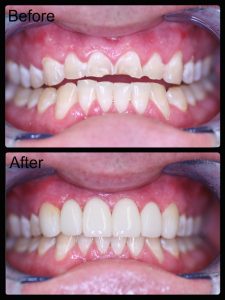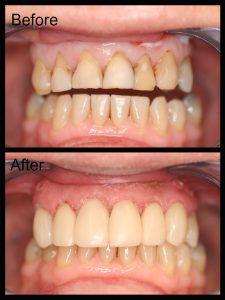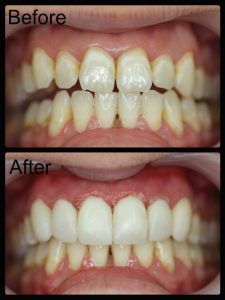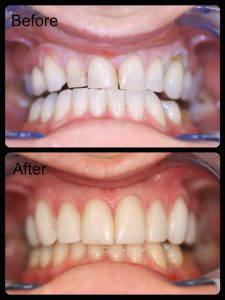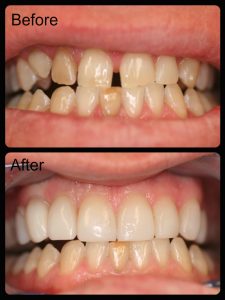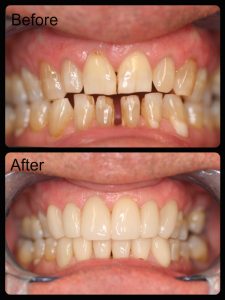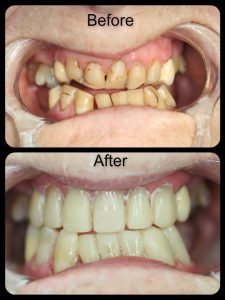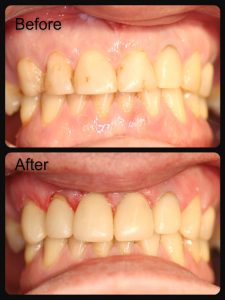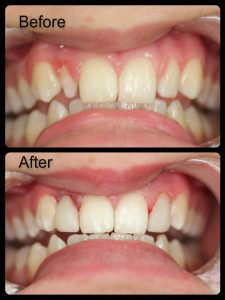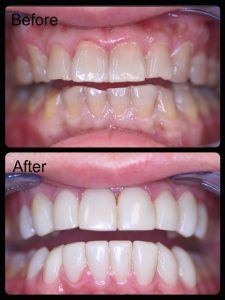Dental Veneers
Dental veneers can improve length, shape, colour, contour and alignment of your teeth.
Dental veneers are usually either a laboratory manufactured ceramic casing or a direct composite resin material, just like the materials used in white fillings, which is applied to the tooth.
At BelleDental, we focus our efforts into composite veneers, as they do not require any loss of existing tooth structure. Ceramic veneers, on the other hand, do require some form of preparation of the tooth in order to place the veneers. This is because ceramic veneers are made in a dental laboratory and require a “margin”: the dental technician can then construct the veneer to the finishing “margin”. In order to create such a margin, the dentist needs to cut away the tooth (dental enamel and usually some dentine) by a minimum of 0.3 millimetre. Yes, I know that 0.3mm is a very small amount of tooth structure.
Why RISK it?
The grinding down of the teeth is why Dr Huszti and Belle Dental would recommend against ceramic veneers if composite veneers are an option.
BelleDental’s Concerns with Ceramic Veneers
- Many dentists claim that the veneers can be as thin as 0.3mm thick. This is true. However, is the dentist capable of preparing a tooth to this minimal degree? I have seen this on occasions, however, I believe that it is rare to find operators with this degree of skill on a consistent basis, especially when preparing 6, 8 or even 10 teeth – I therefore recommend no preparation as ideal for veneers, as no preparation = no risk (the procedure is reversible).
- Assuming a preparation of 0.3mm at the margin of the ceramic veneer – i.e. the thinnest portion of the veneer – the veneer would likely be between 0.5-0.7mm thick at the thickest portion of the veneer. This amount of reduction of tooth structure could be represented by the thickness of a decimal point between the zero and the three in the first line of this paragraph! That amount of dental enamel reduction represents 1/2 to 1/3 of the enamel thickness – this would reduce the durability of the whole tooth by at least 50%.
- By placing a composite resin veneer over the unprepared tooth – the rigidity of the tooth would actually increase.
- Ceramic veneers are notoriously difficult to repair. Yes, they can be repaired with composite resin – however, the optical characteristics of resin are different to ceramic – so the join is almost always evident.
- Redoing the ceramic veneers poses its own problems in terms of shade matching.
- Direct resin veneers can be repaired or even completely resurfaced with resin to create a completely invisible repair.
Are BelleDental’s Direct Resin Dental Veneers ONLY for Cosmetics?
At BelleDental, we don’t get caught up with semantics.
We take composite resin out of a tube and create beautiful, durable teeth for our patients.
I don’t give a damn what you call it – we’re focused on results.
In this way, I can use the same technique that I use to create a direct resin veneer to:
- Restore a broken down tooth
- Replace a conventional crown with a direct resin crown / veneer / build-up
- Improve the alignment of teeth
- Restore a tooth with a CRC
- Repair decay on teeth
- Restore worn teeth
You see, everyone thinks of veneers as a cosmetic instrument… and YES they can be.
Instead I think of composite resin as a restorative instrument that can restore, strengthen, beautify and SAVE teeth.
BelleDental has a laser like focus on saving teeth and in the process creating something beautiful, functional and durable. You can give the result a name like “veneer” or “crown” or “build-up”. The name is irrelevant. The result is EVERYTHING.




